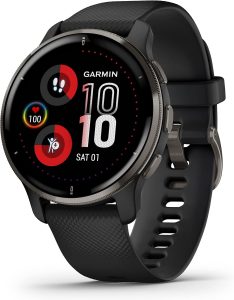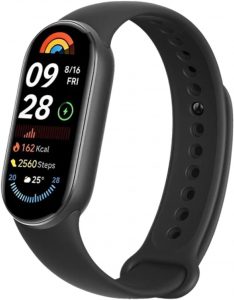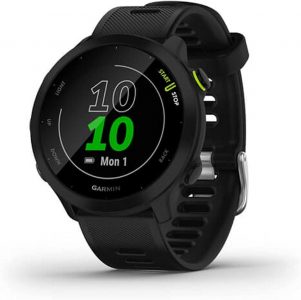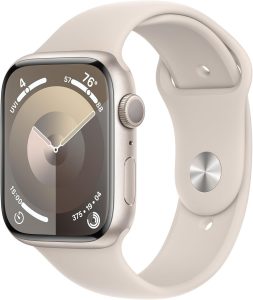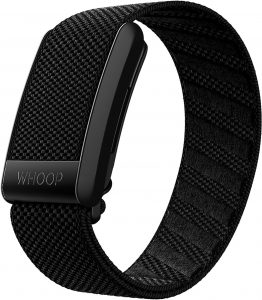The Ultimate Guide to Buying a Fitness Tracker
In today’s fitness-focused world, staying on top of your health goals has never been easier. Whether you’re aiming to lose weight, improve your endurance, or simply monitor your daily activity, a fitness tracker can be a game-changer. These wearable devices provide valuable insights into your physical activity, heart rate, sleep patterns, and more, helping you stay motivated and accountable.
However, with so many options on the market, choosing the right fitness tracker can feel overwhelming. Should you prioritize heart rate monitoring or GPS tracking? Is battery life a crucial factor? And how accurate are these devices really?
This guide will walk you through everything you need to know before purchasing a fitness tracker. From must-have features to the best options available, we’ll help you find the perfect fitness tracker for your lifestyle and goals.
Must-Have Features in Fitness Trackers
When purchasing a fitness tracker, it’s essential to understand the features that will help you achieve your fitness goals. The best device for you depends on your needs—whether you’re tracking daily activity, improving heart health, or training for a marathon. Here’s a deep dive into the must-have features and why they matter.
1. Activity Tracking: The Foundation of Every Fitness Tracker
At the heart of every fitness tracker is the ability to monitor your daily activity levels. A good tracker should provide insights into:
Step Counting & Movement Tracking
Most fitness trackers use accelerometers to count steps. This feature is great for setting daily movement goals, especially if you aim for the recommended 10,000 steps per day. Some advanced trackers also use gyroscopes to differentiate between activities like walking, running, and cycling.
Calorie Burn Estimation
By combining step counts, movement intensity, and heart rate data, fitness trackers estimate how many calories you burn throughout the day. While not 100% accurate, this can still be a useful metric for weight loss or muscle gain goals.
Activity Recognition & Auto-Tracking
Many modern trackers can automatically detect when you start a workout and categorize it (e.g., walking, running, swimming, or cycling). This ensures you don’t forget to log a session and provides more accurate tracking of your overall activity levels.
2. Heart Rate Monitoring: Essential for Health and Fitness Optimization
A heart rate sensor is a crucial feature that helps monitor resting heart rate (RHR) and workout intensity. Here’s how it helps:
Resting Heart Rate (RHR) Monitoring
Your resting heart rate is a key indicator of overall cardiovascular health. Lower RHR often indicates better heart health and improved fitness levels.
Heart Rate Zones for Training
Some trackers categorize your heart rate into zones to optimize workouts:
- Fat Burn Zone (50-70% of max HR) – Best for weight loss.
- Cardio Zone (70-85% of max HR) – Improves endurance.
- Peak Zone (85-100% of max HR) – Best for high-intensity interval training (HIIT).
24/7 Heart Rate Monitoring
Some fitness trackers offer continuous heart rate tracking rather than on-demand readings. This provides better insights into heart rate variability (HRV), which can indicate stress levels and overall fitness.
ECG & Advanced Heart Health Features
Premium models like the Apple Watch Series 9 and Fitbit Sense 2 include ECG (electrocardiogram) sensors, which can detect irregular heart rhythms (such as atrial fibrillation). This is particularly useful for users with heart health concerns.
3. Sleep Tracking: Improving Your Rest and Recovery
A good fitness tracker should help you understand your sleep quality, not just track sleep duration. Here’s what sleep tracking offers:
Sleep Stages Analysis
Most trackers divide your sleep into:
- Light Sleep – Essential for memory and learning.
- Deep Sleep – Crucial for physical recovery and muscle repair.
- REM Sleep – Supports cognitive functions like problem-solving and creativity.
Sleep Score & Insights
Many trackers generate a sleep score based on sleep duration, movement, and disturbances. They may also provide insights into how to improve your sleep hygiene.
Smart Alarms & Sleep Coaching
Some fitness trackers, like Fitbit and Garmin models, offer smart alarms that wake you up at the optimal sleep phase, ensuring you feel refreshed instead of groggy.
4. GPS and Location Tracking: A Must-Have for Runners and Cyclists
Built-in GPS tracking is essential for those who run, cycle, or hike outdoors. There are two types of GPS found in fitness trackers:
Built-in GPS vs. Connected GPS
- Built-in GPS: The tracker has a GPS module inside, allowing it to work without a phone. Great for serious runners, hikers, and cyclists.
- Connected GPS: The tracker uses your phone’s GPS, meaning you must carry your phone to track routes. Suitable for casual users.
Benefits of GPS Tracking
- Accurate Distance and Pace Measurement – Crucial for runners and cyclists.
- Route Mapping – View your running or cycling routes after workouts.
- Elevation Tracking – Helps hikers track inclines and altitude changes.
5. Water Resistance: For Swimmers and Everyday Use
If you plan to wear your tracker while swimming or showering, ensure it has a good water resistance rating.
Understanding Water Resistance Ratings
- IP67 – Splashproof but NOT suitable for swimming.
- IP68 – Can withstand submersion, but not ideal for long swimming sessions.
- 5ATM (50m water resistance) – Suitable for swimming and water sports.
- 10ATM (100m water resistance) – Best for divers and extreme water activities.
Swim Tracking Features
Advanced fitness trackers, like Garmin and Fitbit, offer lap counting, stroke recognition, and swim efficiency tracking.
6. Battery Life: Longer Usage, Less Charging
Battery life varies greatly depending on the model and features.
Average Battery Life by Tracker Type
- Basic Fitness Bands (e.g., Xiaomi Mi Band 8) – Up to 2 weeks.
- Smartwatches (e.g., Apple Watch, Samsung Galaxy Watch) – 1-2 days due to advanced features.
- Advanced Fitness Trackers (e.g., Garmin Venu 2, Fitbit Charge 6) – 5-10 days.
Battery-Saving Features
Some trackers offer battery-saving modes, which disable GPS and continuous heart rate tracking to extend battery life.
7. Smartphone Compatibility & App Integration
A good fitness tracker should sync effortlessly with your smartphone and health apps.
Key Factors to Consider
- iOS vs. Android Compatibility – Apple Watches only work with iPhones, while Garmin, Fitbit, and Xiaomi trackers work on both iOS and Android.
- Third-Party App Integration – Some fitness trackers support apps like Strava, MyFitnessPal, Google Fit, and Apple Health, which enhance your fitness tracking experience.
Smart Features
- Call & Text Notifications – Get alerts on your wrist.
- Music Control – Control Spotify or Apple Music without touching your phone.
- Voice Assistants – Some smartwatches offer Google Assistant, Alexa, or Siri integration.
8. Customization and Comfort: Wear It All Day
A fitness tracker should be comfortable for 24/7 wear. Look for:
Strap Options & Adjustability
- Silicone Straps – Lightweight, durable, and ideal for workouts.
- Metal or Leather Straps – Stylish but less sweat-resistant.
- Adjustable Sizing – Ensures a secure fit for accurate sensor readings.
Display & User Interface
- Touchscreen vs. Physical Buttons – Touchscreens offer easier navigation, but buttons are better for outdoor workouts.
- Always-On Display – Helpful for quick glances but drains battery faster.
- Brightness & Readability – Ensure visibility in direct sunlight.
Which Features Matter Most?
The best fitness tracker depends on your specific needs. Here’s a quick summary:
- Casual users → Step counting, heart rate tracking, and sleep monitoring.
- Runners & cyclists → Built-in GPS, heart rate zones, and long battery life.
- Swimmers → Waterproof rating of 5ATM or higher.
- Serious athletes → Advanced tracking, HRV analysis, and performance metrics.
By prioritizing the features that matter most to you, you’ll be able to choose a fitness tracker that truly supports your health and fitness journey.
Recommended Fitness Trackers
Finding the right fitness tracker depends on your specific needs, whether it’s accurate step tracking, heart rate monitoring, GPS capabilities, sleep tracking, or smart features. Below are some of the best fitness trackers available in 2025, each suited to different types of users.
The Garmin Venu 2 Plus is a feature-rich smartwatch designed for users who want both fitness tracking and smart features in a stylish package. It stands out due to its bright AMOLED display, built-in GPS, and in-depth health tracking.
One of its biggest advantages is its accurate heart rate and SpO2 monitoring, which can provide continuous readings throughout the day and during workouts. The Fitness Age and Body Battery features are particularly useful for understanding how well-rested and recovered your body is before training.
For those who enjoy outdoor activities, the multi-GNSS support ensures precise location tracking, making it a great companion for runners and cyclists. Additionally, it offers on-device music storage, allowing users to listen to Spotify, Deezer, or Amazon Music without carrying a phone.
Battery life is another strong point, lasting up to 11 days in smartwatch mode, making it more reliable than most smartwatches with similar features.
Things to Consider:
- It’s more expensive than basic fitness bands.
- Garmin’s app ecosystem is not as extensive as Apple’s or Google’s.
- Some users may prefer a watch with more third-party app support.
This is a great option for people who want a reliable, high-end fitness tracker with a bright display, built-in music, and accurate health tracking without sacrificing battery life.
For those looking for a budget-friendly fitness tracker that doesn’t compromise on essential features, the Xiaomi Mi Band 8 is a solid choice. It offers a bright AMOLED display, step counting, heart rate monitoring, and sleep tracking—all at a fraction of the cost of premium fitness wearables.
One of the biggest advantages is its exceptionally long battery life, lasting up to 14 days on a single charge. This makes it ideal for users who don’t want to worry about daily charging.
While it doesn’t have built-in GPS, it can still track running and walking routes when paired with a smartphone. It also features 5ATM water resistance, meaning it can handle swimming and showers without issues.
However, the lack of third-party app support may be a downside for users who want deeper integration with Strava, Google Fit, or Apple Health. Additionally, heart rate tracking is not as advanced as premium models, so it may not be the best choice for high-intensity workouts.
Despite its limitations, this fitness band is a great entry-level tracker for people who want basic activity and sleep tracking with great battery life at a low price.
The Garmin Forerunner 255 is designed for serious runners, triathletes, and endurance athletes who need precise GPS tracking, advanced training metrics, and long battery life.
Unlike fitness bands that rely on connected GPS, this watch has built-in multi-band GPS for more accurate distance tracking, even in challenging environments like cityscapes or forests. The Training Readiness Score evaluates sleep quality, heart rate variability (HRV), and stress levels, helping athletes determine whether to push harder or take a recovery day.
For those focused on performance optimization, features like VO2 Max, race predictors, and workout recommendations make it easy to track progress and plan workouts effectively. The 50-hour GPS battery life ensures that even long-distance runners and marathoners can rely on it without constant recharging.
While the button-based interface is practical, some users may find it less intuitive than a touchscreen smartwatch. It also lacks built-in music storage, requiring a smartphone connection for music playback.
This tracker is well-suited for runners who need accurate GPS, in-depth training metrics, and long battery life for endurance training.
For iPhone users who want a seamless smartwatch experience with strong fitness tracking capabilities, the Apple Watch Series 9 is a top contender. It provides comprehensive health tracking, including ECG, blood oxygen monitoring, and AI-powered sleep analysis.
Unlike dedicated fitness trackers, it comes with cellular options, meaning users can make calls, send messages, and stream music without a phone nearby. This makes it particularly useful for people who want an all-in-one wearable for both fitness and productivity.
When it comes to workouts and health monitoring, the integrated Apple Fitness+ platform offers guided workouts, while GPS tracking and heart rate monitoring are among the best in the industry. However, battery life remains a weak point, lasting only 18-24 hours per charge, meaning daily charging is necessary.
Another limitation is that it’s only compatible with iPhones, making it a poor choice for Android users. However, for iPhone users who want a smartwatch with robust health and fitness tracking, this is one of the best options available.
Fitbit Sense 2 – A Fitness Tracker with a Focus on Stress and Sleep Monitoring

The Fitbit Sense 2 is designed for users who are interested in tracking their overall well-being beyond just exercise. It features advanced stress monitoring with an electrodermal activity (EDA) sensor, continuous heart rate monitoring, blood oxygen tracking, and a detailed sleep analysis system.
What makes it unique is the combination of stress tracking and mindfulness tools. The built-in stress management system provides real-time stress alerts and guides users through breathing exercises to improve relaxation. The sleep tracking function is also one of the most detailed, offering insights into sleep cycles, disturbances, and recovery trends.
While the health tracking features are excellent, third-party app support is limited, meaning users who prefer Strava, Google Fit, or Apple Health integration may find it lacking. Additionally, GPS tracking is not as precise as Garmin’s models, making it less ideal for serious outdoor runners or cyclists.
For those looking for a fitness tracker focused on stress management, sleep tracking, and general wellness, this is one of the best options available.
Unlike traditional fitness watches, the Whoop 4.0 is designed specifically for athletes and serious fitness enthusiasts who want detailed recovery insights and strain tracking rather than step counting or notifications.
It does not have a screen, meaning all data must be accessed through the Whoop app. Instead of tracking steps or daily movement goals, Whoop focuses on Heart Rate Variability (HRV), strain levels, and sleep quality, helping users optimize their training and recovery.
One major drawback is that Whoop operates on a subscription model ($30/month), making it a more expensive long-term investment. Additionally, the lack of a built-in GPS means it is not ideal for runners or cyclists who want to track routes directly on their wrist.
However, for those who prioritize recovery, strain management, and sleep optimization, Whoop provides some of the most detailed fitness data available.
Choosing the Right Fitness Tracker for Your Needs
The best fitness tracker depends on your lifestyle and fitness priorities:
- For a premium fitness experience: Garmin Venu 2 Plus
- For an affordable, everyday tracker: Xiaomi Mi Band 8
- For serious runners and endurance athletes: Garmin Forerunner 255
- For Apple users who want a smartwatch with fitness tracking: Apple Watch Series 9
- For stress monitoring and sleep tracking: Fitbit Sense 2
- For athletes focused on performance and recovery: Whoop 4.0
Each of these trackers excels in different areas, so choosing the right one depends on your specific fitness goals and lifestyle needs.
Accuracy and Reliability Concerns in Fitness Trackers
Fitness trackers have come a long way in terms of accuracy, but they are not flawless. Whether you’re tracking steps, heart rate, calories burned, sleep, or GPS routes, there are limitations to consider. Understanding these accuracy concerns will help you set realistic expectations and choose the most reliable fitness tracker for your needs.
Step Counting Accuracy: How Reliable Are Fitness Trackers?
Step counting is one of the most fundamental features of any fitness tracker. Most devices use accelerometers and gyroscopes to detect motion and count steps. However, step counting is not always 100% accurate for the following reasons:
Common Step Tracking Issues:
✅ Overcounting Steps
- Some trackers mistake hand movements for steps, leading to inflated step counts. For example, typing, washing dishes, or gesturing while talking might register as steps.
- Some wrist-based trackers register false steps when riding a vehicle (e.g., in a car, bus, or train) due to vibrations.
✅ Undercounting Steps
- If you walk with hands in your pockets or pushing a stroller, your tracker may not register every step.
- Slow-paced movements (e.g., shuffling while cooking) may be missed.
How to Improve Step Counting Accuracy:
- Wear the tracker on your non-dominant hand to reduce false readings.
- Choose trackers with advanced motion sensors and AI-driven algorithms.
- Regularly calibrate your step count using the app settings.
- Use waistband or clip-on pedometers (like the Fitbit Zip) for improved accuracy.
📌 Best Trackers for Accurate Step Counting:
- Garmin Forerunner series (uses multi-axis motion sensors).
- Fitbit Charge series (better motion filtering algorithms).
Assess Compatibility
Heart rate tracking is essential for fitness and health monitoring, but not all trackers provide precise readings.
How Fitness Trackers Measure Heart Rate
- Optical Heart Rate Sensors (PPG Technology) – Use LED lights to detect blood flow beneath the skin.
- Chest Strap Monitors (ECG Sensors) – Use electrical signals for clinical-grade accuracy.
Heart Rate Monitoring Issues:
🚨 Inaccuracy During High-Intensity Workouts
- Optical sensors struggle to measure rapid heart rate changes during HIIT, sprinting, or weightlifting.
- Sweat, movement, and loose fitting can affect readings.
🚨 Skin Tone and Tattoos Can Affect Accuracy
- Darker skin tones and tattoos absorb more LED light, making it harder for optical sensors to read blood flow accurately.
- Some Fitbit and Apple Watch models adjust LED intensity to compensate.
How to Improve Heart Rate Accuracy:
- Wear the tracker snugly but not too tight.
- Keep the sensor area clean and dry for better readings.
- Use a chest strap (like the Polar H10) for precise heart rate monitoring, especially during intense workouts.
📌 Most Accurate Heart Rate Trackers:
- Apple Watch Series 9 (Advanced Optical + ECG Sensor)
- Garmin Fenix Series (Superior Optical & Chest Strap Support)
- Polar H10 Chest Strap (Best for Athletes & Gym Training)
GPS Accuracy: How Well Do Fitness Trackers Track Routes?
GPS tracking is vital for runners, cyclists, and outdoor enthusiasts. However, not all fitness trackers offer precise location tracking.
Built-in GPS vs. Connected GPS:
- Built-in GPS (More accurate) – The device has a dedicated GPS chip.
- Connected GPS (Less accurate) – Uses your smartphone’s GPS, leading to occasional signal delays.
Factors Affecting GPS Accuracy:
❌ Tall Buildings & Dense Trees – Skyscrapers and forests can interfere with GPS signals, causing inaccurate distance and pace readings.
❌ Weak Satellite Connection – Poor weather conditions or remote areas may disrupt GPS reception.
❌ Fast Movements & Turns – Rapid directional changes (e.g., sprinting around corners) can lead to lagging GPS data.
How to Improve GPS Tracking:
✅ Use Multi-GNSS (Global Navigation Satellite Systems) – Devices supporting GPS, GLONASS, and Galileo have better accuracy.
✅ Start Tracking in an Open Area – Before running or cycling, wait for a strong GPS lock.
✅ Use Track Correction Features – Some apps allow you to manually adjust GPS errors post-workout.
📌 Best Fitness Trackers with Accurate GPS:
- Garmin Forerunner 955 (Multi-band GNSS for extreme accuracy).
- Coros Vertix 2 (Best for trail runners and hikers).
- Apple Watch Ultra (Dual-frequency GPS for better precision).
Calorie Burn Estimates: Are They Reliable?
Many people rely on fitness trackers to track calories burned, but these numbers are often inaccurate.
Why Are Calorie Burn Estimates Flawed?
📌 Calorie tracking is based on formulas, not direct measurement. Fitness trackers estimate calories using:
- Heart rate data
- Step count & movement
- Age, weight, gender, and height
However, they don’t account for factors like metabolism, muscle mass, and individual fitness levels, leading to potential overestimation or underestimation.
How to Improve Calorie Tracking:
✅ Use multiple metrics, including heart rate, steps, and workout intensity, instead of relying on a single number.
✅ Pair with a chest strap heart monitor for better calorie burn accuracy during intense workouts.
✅ Adjust caloric intake manually based on actual weight changes over time.
📌 Best Trackers for Accurate Calorie Estimates:
- Fitbit Sense 2 (Advanced HR tracking for better calorie burn estimates).
- Garmin Fenix 7 (Uses activity-based calorie algorithms).
- Polar Vantage V2 (Accurate for endurance training & sports).
Sleep Tracking: How Well Do Fitness Trackers Monitor Sleep?
Sleep tracking is useful for understanding your sleep habits, but it has accuracy limitations.
Common Sleep Tracking Errors:
❌ Incorrect Sleep Stages – Most trackers estimate light, deep, and REM sleep based on movement and heart rate, which is not as accurate as a clinical sleep study (polysomnography).
❌ Inability to Detect Wakefulness – Some trackers mistakenly classify lying still as sleep, even if you’re awake but not moving.
❌ Discrepancies in Sleep Duration – If you wake up and stay in bed for a while, some trackers may not recognize this wake-up period.
How to Improve Sleep Tracking:
✅ Wear your tracker snugly during sleep for better heart rate and motion detection.
✅ Use sleep coaching apps (e.g., Fitbit’s Sleep Score) for more accurate insights.
✅ Focus on long-term sleep trends, not just nightly readings.
📌 Best Trackers for Sleep Accuracy:
- Fitbit Sense 2 (Advanced Sleep Analytics & SpO2 Monitoring)
- Oura Ring (Best for Sleep Tracking & Recovery)
- Whoop 4.0 (Great for athletes monitoring sleep & recovery metrics)
Are Fitness Trackers Accurate Enough?
While fitness trackers aren’t perfect, they provide valuable trends and insights. Understanding their limitations allows you to interpret data correctly and make informed health decisions.
✅ For general tracking – Most fitness trackers are accurate enough to monitor daily activity levels.
✅ For serious training – Consider using chest straps, dedicated GPS watches, and sleep studies for precise data.
✅ For best accuracy – Choose premium models with AI-driven analytics, dual-band GPS, and chest strap compatibility.
Bottom Line: Fitness trackers aren’t medical devices, but they’re powerful tools when used correctly.
Maximizing Your Fitness Tracker’s Benefits
A fitness tracker is only as useful as the way you use it. Simply wearing one won’t automatically improve your health or fitness. To get the most accurate data, meaningful insights, and real motivation, you need to use your device strategically. Below are key ways to maximize the benefits of your fitness tracker and make it an essential tool for better health, fitness, and overall well-being.
1. Set Clear and Achievable Fitness Goals
One of the best ways to stay motivated is to set realistic and personalized goals based on your fitness level. Most fitness trackers allow you to set custom step goals, calorie burn targets, workout frequency, or sleep improvement objectives.
📌 How to Set Effective Goals:
- If you’re just starting out, aim for 7,000 – 10,000 steps per day, then gradually increase as your fitness improves.
- Instead of generic goals like “exercise more,” set a measurable goal such as 30 minutes of moderate exercise 5 days a week.
- Use the workout reminders in your fitness tracker to stay consistent.
- Track your progress over weeks or months rather than focusing on daily fluctuations.
A well-set goal keeps you accountable and gives you a reason to keep using your tracker regularly.
2. Sync Your Fitness Tracker with Health and Workout Apps
Fitness trackers become more powerful when connected to third-party apps that help analyze data in more detail.
✅ Best Apps to Sync with Your Tracker:
- MyFitnessPal – Helps track calories, macros, and nutritional intake.
- Strava – Ideal for runners and cyclists who want in-depth tracking.
- Google Fit & Apple Health – Collects data from multiple sources in one place.
- Nike Training Club & Adidas Running – Offers guided workouts based on fitness levels.
Why It’s Important: Many fitness trackers don’t provide deep insights on their own, but by syncing with fitness, nutrition, and workout apps, you can get a fuller picture of your health and training progress.
3. Use Heart Rate Zones for More Effective Workouts
Heart rate tracking isn’t just a cool feature—it can help optimize your workouts by ensuring you exercise at the right intensity. Most fitness trackers categorize heart rate into different zones, each with specific benefits:
💙 Resting Heart Rate (RHR): A lower resting heart rate often indicates better cardiovascular fitness. Track changes over time to measure improvement.
💛 Fat Burn Zone (50-70% of max HR): Ideal for weight loss and steady-state cardio exercises such as brisk walking, jogging, or cycling.
❤️ Cardio Zone (70-85% of max HR): Best for endurance training and improving heart and lung capacity.
🔥 Peak Zone (85-100% of max HR): Used for high-intensity interval training (HIIT) and maximum performance.
How to Use This Data:
- If your goal is fat loss, focus on longer workouts in the Fat Burn Zone.
- If you’re training for a race or endurance event, aim for longer sessions in the Cardio Zone.
- For explosive power and HIIT workouts, incorporate short bursts in the Peak Zone.
Using heart rate zones ensures that your workouts are more effective and helps prevent undertraining or overtraining.
4. Monitor and Improve Your Sleep Quality
Sleep tracking is one of the most underrated benefits of a fitness tracker. Poor sleep can negatively impact muscle recovery, energy levels, weight management, and mental focus.
💡 Tips to Improve Sleep Using Your Tracker:
- Check your sleep trends to identify patterns of good and bad sleep.
- Compare different nights to see how factors like caffeine, exercise, and stress affect your sleep.
- Use the sleep coach feature (if available) to get suggestions for improving sleep habits.
- Set a bedtime reminder to stay consistent with your sleep schedule.
- Try a smart alarm that wakes you up at the lightest sleep stage, helping you feel more refreshed.
Better sleep improves overall health and performance, making it one of the most valuable things to track consistently.
5. Stay Consistent and Wear Your Tracker Regularly
A fitness tracker only works if you wear it consistently. If you only wear it during workouts or forget to charge it, you’ll miss valuable data trends.
📌 Ways to Stay Consistent:
- Charge your tracker while showering or during inactive periods to avoid downtime.
- Set daily movement reminders to ensure you stay active.
- If you stop using your tracker, revisit your fitness goals and adjust them to make them more engaging.
- Customize notifications to encourage daily movement but avoid overwhelming alerts that might annoy you.
The more data your tracker collects over time, the more valuable insights you’ll get.
6. Use GPS for Outdoor Workouts and Route Optimization
For runners, hikers, and cyclists, built-in GPS tracking is one of the best features to use. If your fitness tracker has multi-band GPS or GLONASS/Galileo support, it can provide detailed route tracking, elevation data, and pace monitoring.
💡 How to Use GPS for Better Workouts:
- Plan your runs or cycling routes to avoid heavy traffic or rough terrain.
- Compare different workouts to see if your pace and endurance improve over time.
- Track your elevation gain if training for hiking, trail running, or mountain biking.
- Use pace alerts to stay on target during long-distance races.
GPS tracking can help fine-tune your workouts and prevent inconsistencies in route-based training.
7. Customize Your Fitness Tracker for Personalization
Most fitness trackers allow customization to make them more engaging and easier to use.
🔧 Customization Tips:
- Change watch faces to display the most relevant data (steps, heart rate, weather, etc.).
- Use custom workout modes based on your favorite activities (e.g., swimming, yoga, HIIT).
- Set up goal notifications so you receive alerts when you reach daily targets.
- Adjust display settings for better visibility during outdoor workouts.
Making the tracker feel personalized increases the likelihood of long-term use.
Conclusion: Choosing and Using the Right Fitness Tracker for Maximum Results
A fitness tracker is more than just a wearable gadget—it’s a powerful tool that helps you track activity, heart rate, sleep, stress, and workouts. However, its effectiveness depends on how well you use it.
Key Takeaways:
1️⃣ Choose a fitness tracker based on your goals—whether that’s running, sleep improvement, calorie tracking, or stress management.
2️⃣ Wear it consistently to collect long-term data and get more accurate insights.
3️⃣ Use heart rate zones and sleep tracking to optimize your training and recovery.
4️⃣ Sync your tracker with fitness apps to gain more detailed analysis.
5️⃣ Set realistic goals and track progress over time to stay motivated.
With the right fitness tracker and a strategic approach, you can take better control of your health, optimize your workouts, and create long-lasting fitness habits. Whether you’re a casual walker, serious athlete, or someone focused on overall well-being, a well-utilized fitness tracker can make a huge difference in your fitness journey.

